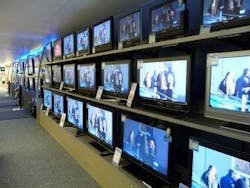Quick Energy Efficiency News…Yes! Appliance Standards…$25M from NYSERDA for Buildings…Bring Your Own Device to this DR Party
Credit: Wikimedia Commons
Quick Energy Efficiency news for this week…
Here’s yet another plug for why energy efficiency appliance standards are a good idea.
Standards for television set-top boxes have cut energy bills by $500 million, according to a new report by independent auditor, D&R International.
The “Voluntary Agreement for Ongoing Improvement to the Energy Efficiency of Set-Top Boxes 2014 Annual Report” says the standards in 2013 and 2014 also avoided nearly three million metric tons of carbon dioxide emissions.
The pay-TV industry, consumer electronics manufacturers and energy efficiency advocates set the voluntary standards.
Digital Video Recorders, the most energy-intensive type of set-top box, achieved the greatest savings — 33 percent over just two years.
Overall, 95 percent of service providers’ set-top box purchases in 2014 met the ENERGY STAR Version 3.0 standards – a 12 percent increase from 2013, the first year of the agreement. They use about 14 percent less energy than earlier set-top boxes.
In addition, 62 percent of last year’s boxes already met the even more stringent set of Tier 2 energy efficiency levels, which will be a new baseline in 2017.
***
The New York State Energy Research and Development Authority (NYSERDA) recently awarded advanced energy building funds to 11 projects.
The funds are from a $25 million program making awards through six rounds. This was the fifth round. Details about an RFP available for the sixth and final round are here.
NYSERDA is partnering with manufacturers, research scientists, building owners and property managers to commercialize new energy-efficient technologies. Support is provided for technologies throughout all stages of the product development, from concept to commercialization, field installation and evaluation.
The winning buildings are in the research and development phase. They include:
Capital Region
- Lower-cost LED materials — Good light LLC (Albany)
- Smart Building Energy Management System for the Zero Energy Nanotechnology (ZEN) Building – SUNY Polytechnic Institute’s Colleges of Nanoscale Science and Engineering (CNSE) (Albany)
- Field testing of LED fixtures with different lighting control strategies to guide users — Rensselaer Polytechnic Institute’s Lighting Research Center (Troy)
Central New York
- Greater efficiency in building cooling — Optimized Thermal Systems Inc. (Syracuse)
- Heating system that also generates power — Syracuse University (Syracuse).
Finger Lakes
- Brighter LED lighting systems — OLEDWorks (Rochester)
Long Island
- LED technology for controlled environments — Autronic Plastics d/b/a Clear-Vu Lighting (Central Islip).
New York City
- Developing metrics to increase use of building automation systems — CUNY Institute for Urban Systems (NYC) · Developing affordable, net-zero manufactured homes — The Levy Partnership Inc. (NYC)
- Integrating smart battery storage with solar power for multlifamily building — Bright Power (NYC)
Statewide
- Self-powered heat pump to increase building resiliency — Gas Technology Institute (Statewide)
***
ThinkEco is working on keeping New Yorkers and Texans cool, this time in deal with Frigidaire that allows its window air conditioners to participate in utility demand response programs.
A Frigidaire air conditioner is now Wi-Fi enabled with ThinkEco’s cloud-based management system. The platform allows utilities to create a new class of demand management in residential and small business customer segments.
The partnership is calling this ‘Bring Your Own Device’ (BYOD) demand response. ThinkEco, in Internet of Things (IoT) company, says such programs leverage consumer buying patterns. They allow utility consumers to opt-in to demand response programs in exchange for rebates.
This technology is now available to utilities around the country, and is already being offered to consumers of Consolidated Edison, through its coolNYC program, and to CPS Energy consumers in San Antonio through the Cool Energy Program.
Frigidaire’s Cool Connect is a Wi-Fi enabled 8,000 BTU room air conditioner. Using the Frigidaire Smart Appliances App from a smartphone, consumers can control the unit from anywhere at any time. Functionality includes powering the unit on or off, changing temperature, controlling modes, and creating custom schedules. Because it’s connected with the ThinkEco smartAC platform, the Frigidaire Smart Appliances App also allows consumers to easily participate in demand response programs.
***
Colleges want to be more energy efficient — big time.
Nine out of 10 colleges in a survey by Schneider Electric and the Alliance to Save Energy said that they expect to increase or maintain energy efficiency investments next year. Eighty-eight percent agreed that energy efficiency is the most cost effective way to meet energy needs, reduce greenhouse gases and cut costs.
“A majority of the higher education buildings that stand today are expected to be in operation for the next few decades,” said Tara Canfield, Schneider Electric segment director, education and commercial office buildings. “Tremendous opportunities exist to improve energy efficiency and reduce waste in these existing buildings.”
Saving money drives schools most to pursue energy efficiency, according to the survey conducted with higher education facility leaders. Environmental benefits and industry standards round out the top three reasons for becoming more energy efficient.
Obstacles do exist for schools as they try to save energy. Toping the list were organizational barriers, insufficient funding and lack of clear definition for success.
Redshift Research conducted the survey in June 2015 of 150 U.S. facilities leaders in higher education.
Subscribe to the Energy Efficiency Markets newsletter to track the latest in energy efficiency news.

